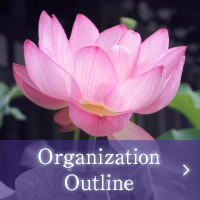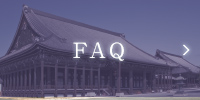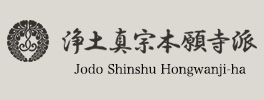History of the Hongwanji
History of the Hongwanji
The Jodo Shinshu Buddhist path was founded by Shinran Shonin (1173-1263) during the Kamakura period, and in several centuries grew into one of the largest and most influential schools of Buddhism in Japan, a position it maintains today. The Hongwanji temple is the headquarters of the Hongwanji denomination of Jodo Shinshu Buddhism (Jodo Shinshu Hongwanji-ha), and is known as Nishi (lit. "West") Hongwanji, due to it being located on the west toward the Higashi (lit. "East") Honganji.
Origins
The Hongwanji developed from a modest temple built at the site of Shinran's mausoleum. After his death, his cremated remains were interred at Otani in the eastern hills of Kyoto and marked by a simple stone obelisk.
Many followers came to pay their respects, particularly from the distant Kanto region (now the Tokyo area), and in 1272, with their support, Shinran's youngest daughter, Kakushinni, had his ashes moved to the grounds of her residence at Yoshimizu, slightly to the north. There, a hexagonal chapel was built and an image of Shinran enshrined.
Several years later, with the death of her husband, title to the residence passed to Kakushinni, allowing her to determine the future of the chapel, and in 1277, she dedicated her property to the Jodo Shinshu movement as a permanent mausoleum, to be tended by a person of Shinran's lineage. The chapel and land became known as the Otani Byodo (Mausoleum) and was largely supported by followers in the Kanto area.
Appointed by Kakushinni was her son, Kakue, and in 1310 he was succeeded by his son, Kakunyo. It was he who elevated the status of the mausoleum by gaining recognition for it as a temple, and further sought to make it the center of the Jodo Shinshu movement introducing the name Hongwanji (lit. "Temple of the Primal Vow").
In so doing, Kakunyo clarified that the Jodo Shinshu teaching was transmitted from Honen to Shinran, his grandson, Nyoshin and then to Nyoshin's nephew Kakunyo himself with the hope of proving his own legitimacy as a successor of Shinran.
In 1336, the Otani Mausoleum was burned during warfare between Ashikaga Takauji and Emperor Godaigo. Kakunyo rebuilt it, not as a hexagonal chapel, but as a regular temple. In succeeding generations, the Hongwanji developed the present format of two halls, the Founder's Hall and the Hall of Amida Buddha. Each regional group of followers during this period continued to develop, eventually becoming the ten Shinshu sects. The original leaders of these groups were direct disciples of Shinran. It was not until the time of Rennyo that the Hongwanji became the center of the Jodo Shinshu tradition, independent from the Tendai organization.
Rennyo Shonin (1415-1499)
Under Rennyo, the eighth generation leader, the Hongwanji grew remarkably. After assuming the role as monshu (head priest of Hongwanji), he spread the teaching in nearby provinces with astonishing success, communicating the teaching in forceful, colloquial language, particularly through the use of written messages that we refer to as the Gobunsho.
The growth of Hongwanji influence in Omi (Shiga prefecture), however, aroused the ire of the Tendai temple on Mt. Hiei, which had traditionally regarded the area as within its jurisdiction. In 1465, warrior-monks from Mt. Hiei raided the Hongwanji and destroyed a number of buildings, and Rennyo was forced to flee.
In 1471, after Omi had been occupied by an unfriendly daimyo (feudal lord), Rennyo settled at Yoshizaki in Echizen (Fukui prefecture). There, his reputation as a great religious leader spread, and he began to attract thousands of followers. The Hongwanji-affiliated temples in Echizen and the neighboring areas grew into a political power, and in an era of constant struggle among daimyos, forces emerged that sought to utilize Hongwanji's strength militarily, or to extend its influence through political alliances.
Rennyo, finding his movement becoming entangled in violent rioting and unable to restrain his followers, chose to withdraw. In 1474, he moved to the Osaka area, and in 1478, he selected Yamashina located southeast in Kyoto as the site for the construction of a magnificent temple complex, completed five years later.
At the age of seventy-four, Rennyo retired as monshu, but continued his work in spreading the teaching. At eighty-two, he established a temple at Ishiyama on Osaka Bay, which he recognized as an ideal site for propagation because of its heavy river traffic. The village that was to grow into the city of Osaka quickly sprang up around the temple.
By the time of his death in 1499, at the age of eighty-five, the small Kyoto temple of his youth had grown into a powerful religious institution.
Ishiyama Hongwanji
The century following Rennyo's death was one of turbulence and momentous change for both the country and the Hongwanji. The period from 1482 to 1558 is known as the age of "the country at war" and was characterized by incessant warfare and shifting alliances among the feudal lords throughout Japan. At the beginning of this period, Jodo Shinshu followers in Echizen and neighboring Kaga arose to virtually dominate those provinces, and for a century the Hongwanji remained an obstacle to the ambitions of warlords bent on dominating the entire country.
In 1532, the Yamashina Hongwanji was attacked and burned to the ground by the Omi daimyo, Rokkaku, and followers of the Nichiren school. It was relocated at Ishiyama which, located on a slight prominence and surrounded by waterways, occupied a strategic position of great strength. It is the site of present Osaka Castle. Hongwanji influence in the area grew.
From the mid-sixteenth century, the warlord Oda Nobunaga emerged as one of the most powerful military leaders, and his drive to control the country brought him into conflict with the Hongwanji. In 1580, after eleven years of military action against the Ishiyama Hongwanji and failure to achieve its downfall, Nobunaga requested the intercession of Emperor Ogimachi, who mediated the evacuation of Ishiyama. The eleventh monshu, Kennyo, moved the Hongwanji to Saginomori in Wakayama prefecture, and then to Kaizuka and Temma in present-day Osaka.
Return to Kyoto
Nobunaga was assassinated in 1582, and it fell to one of his generals, Toyotomi Hideyoshi, to effect final unification of the country. Hideyoshi was supportive of the Hongwanji, and in 1591 donated the tract of land where it stands today. With the relocation of the temple halls from Temma the following year, the Hongwanji returned to Kyoto.
In 1592 Kennyo died and was succeeded by his eldest son, Kyonyo. In his will, however, Kennyo named his third son, Junnyo, to be his successor, and with Hideyoshi's recognition of this will, responsibility passed to Junnyo in 1593. Kyonyo retired, but a decade later, in 1602, he received a parcel of land slightly to the east of the Hongwanji from the shogun Tokugawa Ieyasu. The Hongwanji following was split, and an additional new temple was erected. Commonly referred to as Higashi (lit. "East") Honganji, it became headquarters of the new Otani denomination.
A number of structures, including the Flying Cloud Pavilion, ceremonial gate and Chamber of Waves, appear to have been moved to Hongwanji about this time. The main halls, however, were destroyed in a great earthquake in 1596, and though reconstruction was quickly undertaken, in 1617 a fire swept the compound and the nearly completed buildings burned. Under the direction of Junnyo and his successor, Ryonyo, many of the structures of the present compound were built; most have been recognized as National Treasures and Important Cultural Properties, attesting to the Hongwanji's continuing creativity and vitality. In 1994, the entire Hongwanji precinct received designation as a UNESCO World Cultural Heritage Site.
Junnyo built the Hall of Amida, and the main audience chamber and Shiro shoin complex. The reconstruction of a permanent Founder's Hall was left to Ryonyo who, in addition, built the Kuro shoin chambers and the Meichodo at the Otani mausoleum.
During this period, the Hongwanji temple organization was firmly established in conformity with Tokugawa government policies requiring hierarchical internal structures and fixed temple membership. Further, official encouragement to formulate doctrinal teachings led, in 1639, to the creation of a facility for scholarly study, which was to develop into Ryukoku University, one of the oldest institutions of higher education in Japan.
Beyond National Borders
With the Meiji Restoration in 1868, Japan entered a period of rapid modernization, but it was also a time of crisis. The new government adopted a strong anti-Buddhist attitude, and a movement to eradicate Buddhism and bring Shinto to ascendancy arose throughout the country. It was precisely at this time that the twenty-first monshu, Myonyo, took office.
Myonyo was energetic in protecting religious freedom and successfully struggled against state control of temple activities. To advance the Jodo Shinshu tradition, as early as 1872 he began sending advisors and students abroad to investigate religious thought and practices throughout the world. In 1888, in response to interest among Buddhists in Europe and America, the Hongwanji published a journal in English, and also highly-regarded reports in Japanese on religious conditions abroad.
At home, he broke down the rigid hierarchy of branch temples and directly involved local temples throughout the country in governing the Hongwanji. He also built schools, orphanages and other social welfare facilities, and created a program of prison and military chaplaincy. In 1897, the Hongwanji began sending official ministers to establish temples for Japanese immigrants in the then Kingdom of Hawaii and North America.
In 1903, Myonyo was succeeded by Kyonyo (Ohtani Kozui), who continued to broaden the vision and scope of Hongwanji activities. He is known in particular for the Otani expeditions to Buddhist sites in central Asia, which recovered many texts and artifacts from the deserts across which Buddhism had been transmitted to Japan over the Silk Road.
Jodo Shinshu missions in Europe started after the twenty-third monshu, Shonyo (Ohtani Kosho), made a tour in 1954. Today, the Hongwanji is the head temple for approximately ten thousand temples throughout Japan and some two hundred temples around the world.
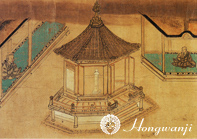
Otani Mausoleum (Zenshin Shonin-e, Pictorial History of Zenshin (former name of Shinran Shonin), Important Cultural Property)
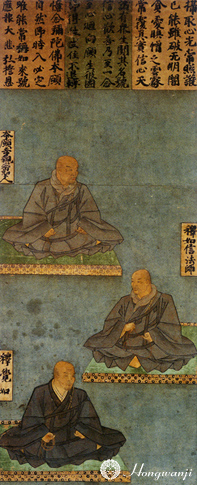
Portrait of Shinran, Nyoshin, and Kakunyo (Important Cultural Property)
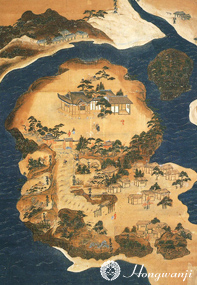
Old Illustrated Map of Yoshizaki Hongwanji (Property of Shosaiji Temple, Shiga prefecture)
